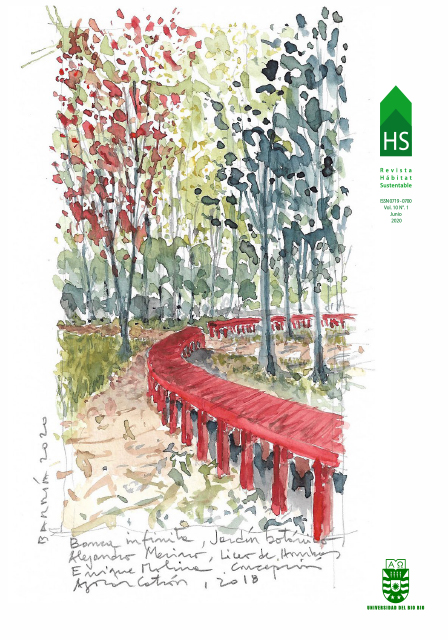Comportamiento térmico de tres prototipos en Saltillo, Coahuila (bloques de tierra, concreto y tapa de huevo)
DOI:
https://doi.org/10.22320/07190700.2020.10.01.02Palavras-chave:
Bloque, edificación, temperatura ambientalResumo
El cambio climático se ha ido agravando en el siglo XX, genera modificaciones estacionales a nivel global en el hábitat, se observan variaciones importantes en los factores climáticos, aumentando las temperaturas en las ciudades. En México el acondicionamiento térmico de las viviendas repercute en gran medida sobre la demanda de electricidad, siendo mayor en las zonas norte y costeras del país, el rol de la envolvente es mantener un equilibrio entre el exterior y el interior, refiriéndose a las ganancias o pérdidas de calor, que se logran a través de su transferencia producto de las variaciones de la temperatura. El objetivo del trabajo fue comparar el comportamiento térmico de tres módulos ubicados en Saltillo, Coahuila; construidos de tres distintos materiales: uno experimental y dos de uso común en las viviendas de Saltillo, la metodología es de enfoque cuantitativo, se realizaron mediciones del 2018 al 2019, los resultados muestran que el material experimental con respecto a los otros materiales comerciales no tienen diferencias relevantes en los meses más críticos que son enero y mayo, apenas 1 o 2 grados, por lo que es pertinente seguir experimentando y complementar con un sistema pasivo, como un pozo canadiense, con la meta de mejorar el confort en el hábitat construido.
Downloads
Referências
Calderón, F. (2019). Evaluación del mejoramiento del confort térmico con la incorporación de materiales sostenibles en viviendas en autoconstrucción en bosa, Bogotá, Colombia. Revista Hábitat Sustentable, 9(2), 30-41.
Comisión Nacional para el Conocimiento y Uso de la Biodiversidad, CONABIO. Portal de Geoinformación Sistema Nacional de Información sobre Biodiversidad 2020. Recuperado de http://www.conabio.gob.mx/informacion/gis/layouts/clima1mgw
Costantini, A.B., Carro Pérez, M.E. y Francisca, F.M. (2016). Evaluación del comportamiento térmico de una edificación reemplazando el material de la envolvente por suelo cemento. Argentina de Energías Renovables y Medio Ambiente, 4, 05.43-05.53.
Delfín, C. A., Gallina, S. A. y López, C. A. (2014). El hábitat: definición, dimensiones y escalas de evaluación para la fauna silvestre. En S. A. Gallina y C. A. López (Eds.), Manual de Técnicas para el estudio de la fauna (pp. 283-317). Recuperado de http://www2.inecc.gob.mx/publicaciones2/libros/717/cap13.pdf
Espinoza, G., Cordero, D., Ruíz, A. y Roux, R. S. (2017). Análisis de aislamiento en tres sistemas de muro como envolvente alternativo. Revista Legado de Arquitectura y Diseño, (21), 119 – 133.
García, S., Kochova, L., Pugliese, G. y Sopoliga, P. (2010). Uso de la energía en los edificios. Manual para estudiantes. Proyecto IUSES y Programa de Energía Inteligente para Europa. Recuperado de https://docplayer.es/16550130-Uso-de-la-energia-en-losedificios-manual-para estudiantes.html
Herrera, L. C. (2017). Evaluación térmica del material isoblock en el clima cálido seco de cd. Juárez, México. Revista Hábitat Sustentable, 7(2), 18-27.
Huelsz, G., Molar, M. E. y Velázquez, J. (2014). Transferencia de calor en la envolvente arquitectónica y en el ser humano. En M. E. Molar, J. Velázquez y J. López, Vivienda 2 (pp. 7-22). Saltillo: Universidad Autónoma de Coahuila.
Luna L. A. (2019). CONFORT ANSI ASHRAE. Herramienta diseñada en Excel para estimar límite de confort. Mexicali: UABC.
Molar, M. E. y Huelsz, G. (2017). Comparación del comportamiento térmico de muros de concreto armado y de bloques de concreto huecos. Revista Legado de Arquitectura y Diseño, 1(22), 1-12.
Molar, M. E., Velázquez, J. y Gómez, A. B. (2018). Estudio del comportamiento térmico de las viviendas respecto a su orientación. México: Revista de Arquitectura y Diseño, 2(3), 1-7.
Molar, M. E., Ríos, J., Bojórquez, G. y Reyes, J. A. (2020). Determinación de profundidad óptima para intercambiadores de calor tierra-aire en Saltillo, Coahuila. Research Journal Aplicaciones de la Ingeniería, 1(1), 1-15.
Molina, J. O., Lefebvre, G., Horn, M. y Gómez, M. M. (2020). Diseño de un módulo experimental bioclimático obtenido a partir del análisis de simulaciones térmicas para el centro poblado de Imata (4519 m s.n.m.) ubicado en Arequipa, Perú. Inf. tecnol., 31(2) 173-186. http://dx.doi.org/10.4067/S0718-07642020000200173.
Morris, G. D. (2017). Building Heat Transfer. Estados Unidos de América: Wiley.
Múnera, M. C. (2011). Construcción social del hábitat: Más allá de una política de producción de vivienda. Recuperado de http://construccionsocialdelhabitat.files.wordpress. com/2011/04/construccic3b3n-social-del-hc3a1bitat.pdf
Muñoz Vásquez, M., Marino, B. M. y Thomas, L. P. (2015). Caracterización del comportamiento térmico de un edificio prototipo en Tandil (Buenos Aires). Revista ANALES AFA, 26(2), 1-10. Recuperado de https://afan.df.uba.ar/journal/index.php/analesafa/article/view/2038
Organización Panamericana de Salud (OPS). (octubre de 1999). Documento de Posición (OPS) sobre Políticas de Salud en la Vivienda. Organización Mundial de la Salud Organización Panamericana de la Salud. Recuperado de: http://www.bvsde.paho.org/bvsasv/e/iniciativa/posicion/posicion.html
Rodríguez, N. A., Nájera, M. y Martín, I. R. (2018). Análisis del desempeño térmico de los sistemas constructivos de un edificio de oficinas mediante simulaciones dinámicas. Revista Ingeniería Investigación y tecnología, XIX(3), 279-289. http://dx.doi.org/10.22201/fi.25940732e.2018.19n3.024
Roux, R. S. (2018). Bahareque y su inercia térmica para muros de vivienda. Revista LEGADO de Arquitectura y Diseño, (23), 25-32.
SENER y CONUEE (2011). Guía rápida para el cálculo de la NOM 020. Recuperado de https://energypedia.info/images/6/6d/GIZ_Gu%C3%ADa_r%C3%A1pida_NOM-020-ENER-2011.pdf
Szokolay, S. (2014). Introduction to architectural science: the basis of sustainable design. Third edition. London: Architectural Press.
Velázquez, J. y Molar, M. E. (2016). Material alternativo con tapas de huevo para cubierta. Revista del Desarrollo Urbano y Sustentable, 2(4), 35-42.
Downloads
Publicado
Como Citar
Edição
Secção
Licença
O conteúdo dos artigos publicados em cada número do Habitat Sustentável é da exclusiva responsabilidade dos autores e não representa necessariamente o pensamento ou compromete a opinião da Universidad del Bío-Bío.
Os autores mantêm os seus direitos de autor e concedem à revista o direito de primeira publicação da sua obra, que está simultaneamente sujeita à Licença de Atribuição Creative Commons CC BY-SA que permite a outros partilhar, transformar ou criar novo material a partir desta obra para fins não comerciais, desde que a autoria e a primeira publicação nesta revista sejam reconhecidas, e as suas novas criações sejam licenciadas sob os mesmos termos.











 Programa de Informação Científica/Concurso Fondos de Publicación de Revistas Científicas 2018/ Proyecto Mejoramiento de Visibilidad de Revistas UBB (Código:FP180007)
Programa de Informação Científica/Concurso Fondos de Publicación de Revistas Científicas 2018/ Proyecto Mejoramiento de Visibilidad de Revistas UBB (Código:FP180007)





